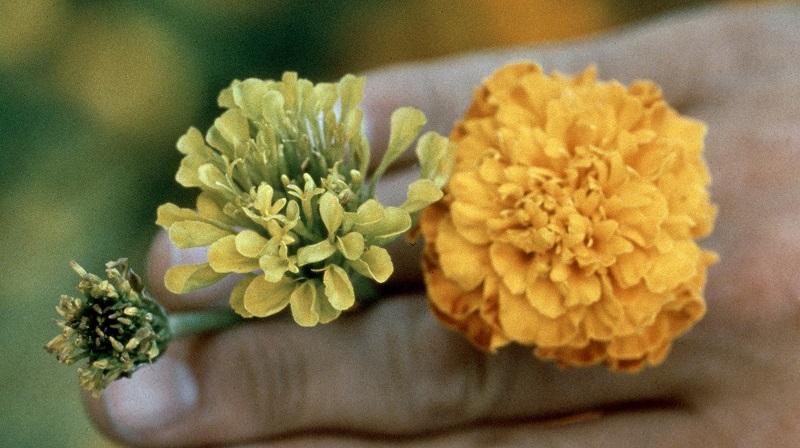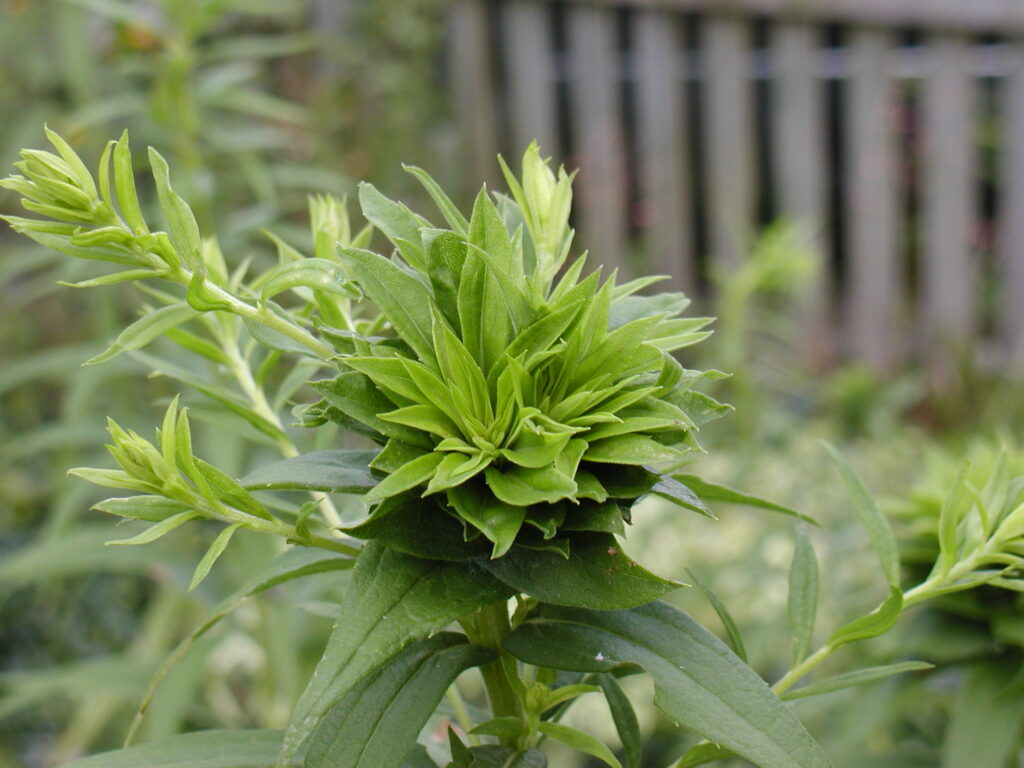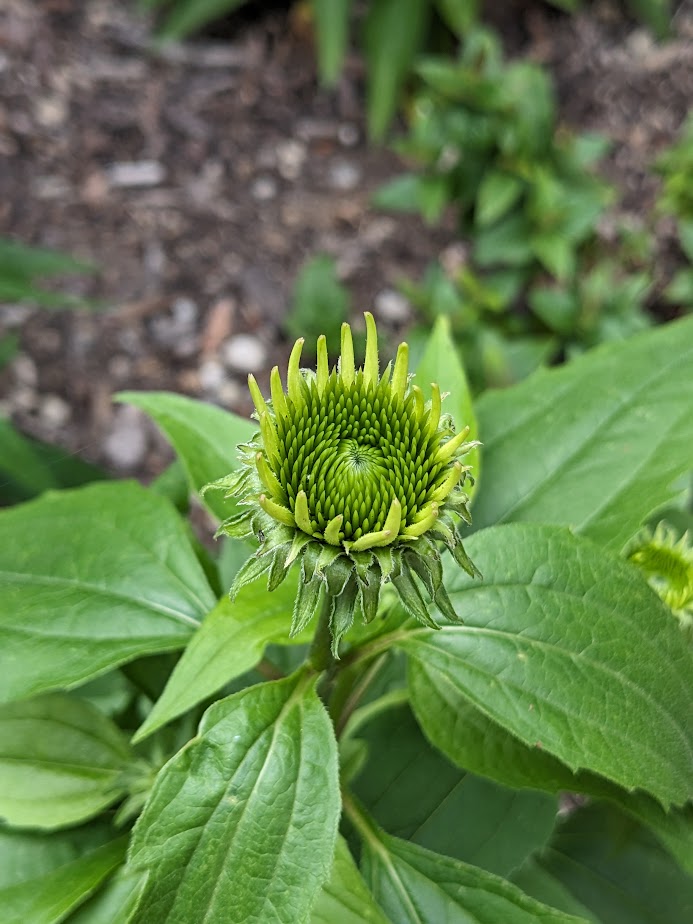For those who have heard of it, or been unlucky enough to experience it first-hand, aster yellows is a scary proposition in your garden. In this article, we’ll explore aster yellows including tips for how to diagnose it and what actions to take.

What is Aster Yellows and What Causes It?
Aster yellows is a plant disease caused by a phytoplasma, a type of bacteria-like organism, which affects a wide range of plant species including native wildflowers, ornamental perennials, and vegetables.
This phytoplasma is primarily spread by leafhoppers and other insects. Once a plant becomes infected, the phytoplasma multiplies and spreads throughout the plant’s vascular system, interfering with its normal growth and development. Unfortunately, there is no cure for aster yellows.
Diagnosing Aster Yellows in Native Plants
Aster yellows can infect a wide range of plant species, but it is particularly common in native plants. Some commonly affected species include coneflowers (Echinacea spp.), goldenrods (Solidago spp.), milkweeds (Asclepias spp.)
There are a few different key indicators that can help you identify the presence of aster yellows:
- Abnormal Flowering: Infected plants may produce distorted flowers with unusual shapes, colors, or missing parts. Flowers may also become green, leaf-like, or fail to develop altogether.
- Leaf Deformities: Look for leaves that are narrow, elongated, or twisted. They often also exhibit chlorosis, or yellowing.
- Stunted Growth: Infected plants often display stunted growth, with shorter stems and reduced overall vigor.
- Phyllody: Phyllody refers to the abnormal development of flower parts into leaf-like structures. This is a common symptom of aster yellows, especially in plants like coneflowers.

What To Do if You Think Your Natives May Have Aster Yellows?
If you think something is off about your native plants and you think you may have aster yellows, the question of what to do can be a tricky one.
For one, the disease won’t completely kill the affected plants, so you may feel tempted to keep the plants around and see how they do the following year. Although this makes sense in general, it is not a good decision when dealing with aster yellows.
The pathogen won’t go away and will continue to live on in your plants, and infected perennials can easily transmit it to other plants nearby. This means that the entire plant, including its root system, needs to be removed in order to minimize the spread. (And also make sure you bag it up and dispose of it; don’t add it to your compost.)
It can be disheartening to have to dig up your beautiful native plants, but it’s unfortunately necessary to ensure that aster yellows doesn’t inflict even more damage.
The really difficult part is that it can be hard to definitively diagnose aster yellows instead of other, less dangerous conditions. Even just environmental stress can exhibit some of the same symptoms. You do want to act quickly if aster yellows is truly upon you, but you don’t want to overreact and dig up your garden if it might be something else.
If there is a plant that concerns you, there are a few questions you can ask yourself to help you determine the best course of action.
If the flowers seem off, is the rest of the plant normal or does its growth seem significantly stunted? This is probably the most important factor that you should consider.
If you have leaves with some yellowing, which is a major aster yellows symptom, is it significant or a slight discoloration and/or curling? You still may want to wait until you see some really severely-deformed flowers and leaves before taking major action on a removal.
One particular condition that can be confusing is found in coneflowers, as coneflower rosette mites can make your plants display some similar symptoms but it is a far less serious proposition than aster yellows.
These mites live in the buds and suck out nutrients as the flower buds develop, which can lead to distorted flowers, missing petals, or petals popping up in odd places.
Determining if your coneflowers have aster yellows or coneflower rosette mites can be challenging, but one indicator can be the overall health and vigor of the plants, as aster yellows will cause much more stunted growth on average.
These mites still aren’t completely understood but will likely not exhibit phyllody to the same degree as aster yellows, so if your coneflowers show abundant bizarre green leaf patterns popping out instead of flowers, it’s likely to be aster yellows.
(But making it even more confusing, the mites are thought to be able to cause some of this. For a thorough look at the differences, check out this article from OSU extension.)
If coneflowers rosette mites seem the more likely diagnosis, the entire plants aren’t doomed but you should cut and dispose of the affected flowers to reduce future mite populations.
Even totally healthy plants can sometimes concern gardeners who have become wary of aster yellows. Sticking with the coneflower example, developing flowers of the straight species of echinacea purpurea (purple coneflower) start off looking green and yellow and if you keep looking at it you may start to worry. But in this case don’t fret, as it will soon change color and look perfectly normal. This would be one example where you don’t want to take any drastic action prematurely.

Another such case could be a few yellow and curling leaves on a plant like milkweed (asclepias) which can be caused by any number of factors and will often fix themselves with time. You can always snip off a problematic leaf or two and see what happens with the new growth.
More Tips for Management, Control, and Prevention of Aster Yellows
Since the disease cannot be treated, we are limited to preventative measures for lowering the risk of aster yellows. Many control measures may be attractive to ornamental or vegetable gardeners but not recommended for native plant gardeners.
Some extension services may suggest products that can help prevent leafhoppers from feeding on your plants, but not many pollinator gardeners will want to apply anything that could harm insects. Other solutions like protecting the plants with floating row covers can work, but this would also keep the insects away that you are likely trying to attract. Another suggestion could be to put strips of aluminum foil between plant rows, which “serves to confuse the leafhoppers, who are then less likely to land on your crops.”
Another control measure can be to plant less susceptible plant species. We’ve already mentioned the natives that tend to be the most commonly affected. Lists of the least susceptible plants include geranium and salvia.
Some common weeds you may have in wilder areas of your yard may also harbor the disease, in particular plantain and dandelion. Removing excesses of these plants can help avoid a potential spread if they were to become infected.
Overall, aster yellows can be a scary and frustrating disease for native plant enthusiasts, but with proper diagnosis and management, its impact can be minimized. By familiarizing yourself with the symptoms, distinguishing it from similar conditions like coneflower rosette mites, and implementing effective control measures, you can protect your garden and promote the health of your native plants. Remember, early detection and preventive actions are crucial in reducing the spread of aster yellows. This will help you enjoy the beauty and ecological benefits of your native plantings while keeping them healthy and disease-free.
I’m unable to find any information on whether the aster yellows pathogen is harmful to humans if ingested from a plant root that had the disease. Do you have an answer to that question?
Hi Gracie, good question and you’re right that it doesn’t seem like that exact answer is easy to find! Based on my understanding I do not believe it can harm humans; the consensus seems to be that the pathogen can only live in the leafhoppers or the plants. I also found sources saying that it “does not affect the health of humans or animals.” Since its caused by a phytoplasma you could search for that as a keyword too. And I haven’t seen anything talking about ingesting an infected plant root specifically, so that might be a good question to ask your local county extension office since their staff is talked with answering all types of questions about plants including diseases.
I have an echinacea that I suspect is infected with Asters Yellow and have removed it. I collected seed last year from this plant. Can those seed be used or should they be tossed as well? This is a cultivar hard to get now and one of my favorites.
Hi Joanne, that’s a good question as well. From what I’ve been able to find, most sources say that the aster yellows phytoplasma does not spread via seed, but at least one source I found cites some research seeming to indicate it is possible, but unlikely (http://canola.okstate.edu/cropproduction/diseases/Aster%20yellows%20Q-A.pdf).
In your case, though, I’d think that if you collected it last year before it was infected, then it should be fine. And aster yellows also typically causes sterility so either no seeds are produced or they aren’t viable, so you wouldn’t lose anything by trying.
But finally, I think that seeds from most echinacea cultivars won’t necessarily grow true to their parent plant; you could see the straight species or any number of variations in between. But not sure on your specific variety, of course.
I have lost all of my Echinacea purpura this year–last year just a few. Two questions:
1. Where I lost the E. purpurea last year, other nearby echinacea self-seeded. All of those and the returning plants were infected this year. Is this just an awful coincidence or is it possible that I didn’t get all of the roots and/or does aster yellows remain in the soil? My gut says it was left-over roots although they were dug out and shovel cleaned.’ Now I have infected Rudbeckia as well in a different area.
2. Do you know of a variety of Echinacea that is resistant to aster yellows?
Thank you! Wonderful article.
Hi Cathy,
Sorry to hear that! The disease wouldn’t be able to survive in the soil without a host plant, but I do see some sources saying that the phytoplasma can overwinter in plant roots. It also seems likely that the leafhoppers could have spread the disease + themselves more widely last year than the most obvious infected echinacea and it continued spreading into this year. I know how frustrating that is to have to deal with. I’m not aware of any echinacea that are resistant, but some sources suggest that echinacea pallida and echinacea tennesseensis are less susceptible than purpurea. Best of luck to recovering this part of your garden.